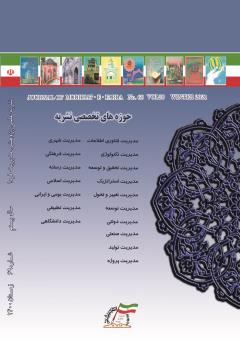Designing an evaluation model of the effective factors on customers’ satisfaction with a system dynamics approach in the ceramic tile industry of Yazd province
Subject Areas :amir ehsan Ishaqiyeh Firouzabadi 1
1 - PhD in Public Administration, Islamic Azad University, Yazd Branch
Keywords: : Customers', satisfaction, Ceramic tile industry, Simulation, System dynamics,
Abstract :
Abstract IntroductionTherefore, the purpose of this study is to present a simulated model of factors affecting customer satisfaction based on dynamic methodology in order to analyze the factors and also improve customer satisfaction. Method:This research is applied in terms of purpose and analytical-descriptive in terms of data collection from the survey branch. First, the initial and proposed model was drawn based on the research background and literature. The statistical population in the present study includes three groups of experts and specialists, information and data and personnel of the ceramic tile industry in Yazd province. At first, a panel of experts (15-20) people were selected and dynamic and key variables affecting the model were identified through semi-structured interviews.While collecting statistical data and financial information, a questionnaire was prepared using the opinion of experts and measured using factor analysis. Results: through simulation by Vensim, show that factors that increase customer satisfaction include quality, product diversity, and on-time delivery and factors that decrease customer satisfaction include ceramic tile import from other countries, low quality, high price, and lack of on-time delivery. Conclusion: Therefore, companies' attention to the model presented in this study can have a significant effect on increasing customer satisfaction. Managers can also play an effective role in increasing customer satisfaction by adopting strategic and creative policies.
Arvi, Mehran, Faezi Razi, Farshad and Danaei, Abolfazl (2019). Identifying and analyzing quality customer satisfaction criteria using fuzzy network analysis model (FANP Case study: Valves managers and experts). Quarterly Journal of Business Research, No. 91, 124-91.
Bozorgi, M. M. (2007). Measuring Service Quality in the Airline Using Servequal Model, Master Thesis, Lulea University of Technology.
Cutler, F. and Armstrong, A. (2005). Marketing Manager, Bahman Forouzandeh Translator. Tehran: Atropat.
Dyson, B and Chang, N. B. (2005). Forecasting municipal solid waste generation in a fast-growing urban region with system dynamics modeling. Waste management.26T 26T25(7). Pp. 669-679.
Evans, T. P.; Manire, A.; de Castro, F.; Brondizio, E and McCracken, S. (2001). A dynamic model of household decision-making and parcel level landcover change in the eastern Amazon. Ecological Modelling. 143(1). Pp. 95-113.
Jafari, Seyed Mohammad Baqer and Yaghoubi Jahromi, Zeinab (2018). The Impact of Applying Social Customer Relationship Management (SCRM on Customer Relationship Performance. Journal of Business Management Research, Vol. 10, No. 20, 115-134.
Johnston, M.W., & Marshall, G.W., (2016). Sales force management: Leadership, innovation, technology, Routledge.
Hasenmark, O. a. (2004). Customer Satisfaction and Retention: The Experiences of Individual Employees. Managing Service Quality, 14(1), 40-57.
Mir Ghafouri, Habibollah, Marvati Sharifabadi, Ali and Taki, Ensieh (2014). Investigating the Factors Affecting Customer Satisfaction, with Customer Relationship Management Approach Using Fuzzy Delphi Method and System Dynamics Model (Case Study: Mobarakeh Steel Complex of Isfahan), Scientific-Research Quarterly of New Marketing Research, Year 5, Issue 3 18), 199-218.
Mohebbi H, Zare Mehrjardi AR. Investigating the Effect of Proactive market Orientation on Creating Market Changes and its Consequences in the tile and ceramic industry. journal of business surveys. 2020; 17(98): 98–113.
Nazemi, Amir, Aristocracy, Mozhdeh and Testers, Mahdiyeh (2017). Guide for the formation and implementation of specialized panels, Tehran, National Forecasting Program. National Presidium Secretariat. Guide to the formation and implementation of specialized panels.
Oliver, R. L. (1997). Satisfaction: A Behavioral Perspective on the Consume, Irwin, Mc Graw – Hill Company.
Sharif Fard, Nasrullah (2018). Vice President of the Iranian Ceramic Tile Association, ISNA News Agency.
Shi, T. & Gill, R. (2005). Developing effective policies for the sustainable development of ecological agriculture in China: the case study of Jinshan County with a systems dynamics model.26T 26Tecological Economics.26T 26T53(2). Pp. 223-246.
Sharif fard, N(2018), Vice President of the Iranian Ceramic Tile Association, ISNA News Agency.
Venus, Ahmed (2004). Branding Services Marketing for Iranian Banks, Negah Publishing. Watson, H. J and Wixom, B. H. (2009). An empirical investigation of the factors affecting data warehousing success. MIS Quarterly, 25(1), 17-41.
Zaim, s., Turkyilmaz, A, Tarim, M., Ucar, B. and Oguz A.( 2010). Measuring customer satisfaction in Turk Telekom Company using structural equation modeling technigue, Journal of Global Strategic Management. 14 (1), pp.89-99.
Zaim. S, Bayyurt. N, Tarim. M, Zaim. H, Guc. Y.(2013). System dynamics modeling of a knowledge management process: A case study in Turkish Airlines, rocedia – Social and Behavioral Sciences.
Zivyar, Farzad, Ziaei, Mohammad Sadegh and Nargesian, Javad (2012). Investigating the Factors Affecting Customer Satisfaction Using the Cervocal Model, Journal of Modern Marketing Research, Second Year, Third Issue, Sequential Issue (6), 172-186.


